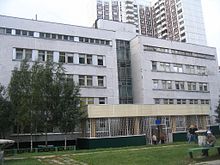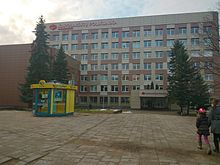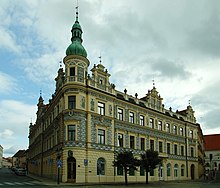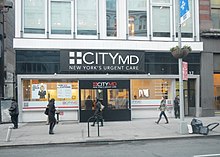Clinic

Aclinic(oroutpatient clinicorambulatory care clinic) is ahealth facilitythat is primarily focused on the care ofoutpatients.Clinics can be privately operated or publicly managed and funded. They typically cover theprimary careneeds of populations in local communities, in contrast to largerhospitalswhich offer more specialized treatments and admitinpatientsfor overnight stays.
Most commonly, the English wordclinicrefers to ageneral practice,run by one or moregeneral practitionersoffering small therapeutic treatments, but it can also mean aspecialistclinic. Some clinics retain the name "clinic" even while growing into institutions as large as major hospitals or becoming associated with a hospital ormedical school.
Etymology
[edit]
The wordclinicderives from Ancient Greekκλίνεινklineinmeaning to slope, lean or recline. Henceκλίνηklinēis a couch or bed andκλινικόςklinikosis a physician who visits his patients in their beds.[1]In Latin, this becameclīnicus.[2][3]
An early use of the word clinic was "one who receives baptism on a sick bed".[4]
Overview
[edit]
Clinics are often associated with a general medical practice run by one or severalgeneral practitioners.Other types of clinics are run by the type of specialist associated with that type:physical therapyclinics byphysiotherapistsand psychology clinics byclinical psychologists,and so on for each health profession. (This can even hold true for certain services outside the medical field: for example,legal clinicsare run bylawyers.)
Some clinics are operated in-house by employers, government organizations, or hospitals, and some clinical services are outsourced to private corporations which specialize in providing health services. InChina,for example, owners of such clinics do not have formal medical education. There were 659,596 village clinics in China in 2011.[5]
Health care inIndia,China,RussiaandAfricais provided to those regions' vast rural areas by mobile health clinics or roadsidedispensaries,some of which integratetraditional medicine.In India these traditional clinics provideayurvedicmedicine andunaniherbal medical practice. In each of these countries,traditional medicinetends to be a hereditary practice.
Function
[edit]
The function of clinics differs from country to country. For instance, a local general practice run by a single general practitioner providesprimary health careand is usually run as afor-profitbusiness by the owner, whereas a government-run specialist clinic may provide subsidized or specialized[dubious–discuss]health care.
Some clinics serve as a place for people with injuries or illnesses to be seen by atriagenurse or otherhealth worker.In these clinics, the injury or illness may not be serious enough to require a visit to anemergency room(ER), but the person can be transferred to one if needed.
Treatment at these clinics is often less expensive than it would be at a casualty department. Also, unlike an ER these clinics are often not open on a 24/7/365 basis. They sometimes have access to diagnostic equipment such asX-raymachines, especially if the clinic is part of a larger facility. Doctors at such clinics can often refer patients to specialists if the need arises.[6]
Large outpatient clinics
[edit]
Large outpatient clinics vary in size, but can be as large as hospitals.
Function
[edit]Typical large outpatient clinics house general medical practitioners (GPs) such asdoctorsandnursesto provideambulatory careand someacute careservices but lack the major surgical and pre- andpost-operative carefacilities commonly associated with hospitals.

Besides GPs, if a clinic is apolyclinic,it can house outpatient departments of some medical specialties, such asgynecology,dermatology,ophthalmology,otolaryngology,neurology,pulmonology,cardiology,andendocrinology.In someuniversity cities,polyclinics contain outpatient departments for the entire teaching hospital in one building.
Internationally
[edit]
Large outpatient clinics are a common type of healthcare facility in many countries, including France, Germany (long tradition), Switzerland, and most of the countries of Central and Eastern Europe (often using a mixed Soviet-German model), as well as in former Soviet republics such as Russia and Ukraine;[7]and in many countries across Asia and Africa.[8]
In Europe, especially in the Central and Eastern Europe, bigger outpatient health centers, commonly in cities and towns, are calledpoliclinics(derived from the word polis, not from poly-).
Recent[when?]Russian governments have attempted to replace the policlinic model introduced during Soviet times with a more western model. However, this has failed.[9]
In theCzech Republic,many policlinics were privatized or leasehold and decentralized in the post-communist era: some of them are just lessors and coordinators of a healthcare provided by private doctor's offices in the policlinic building.[10]
India has also set up huge numbers of polyclinics for former defense personnel. The network envisages 426 polyclinics in 343 districts of the country which will benefit about 33 lakh (3.3 million) ex-servicemen residing in remote and far-flung areas.[11]
Policlinics are also the backbone of Cuba's primary care system and have been credited with a role in improving that nation's health indicators.[12]
Mobile clinics
[edit]

Providing health services through mobile clinics provides accessible healthcare services to these remote areas that have yet to make their way in the politicized space. For example, mobile clinics have proved helpful in dealing with new settlement patterns in Costa Rica. Beforeforeign aid organizationsor the state government became involved in healthcare, Costa Rica's people managed their own health maintenance and protection.[13]People relied on various socio-cultural adaptations and remedies to prevent illnesses, such as personal hygiene and settlement patterns.[13]When new settlements that sprang up along the coast became "artificial" communities, and due to lack of traditional home healing practices here, alternative methods such as mobile clinics had to be implemented in these communities for the protection and prevention of diseases.[13]
A study done in rural Namibia revealed the health changes of orphans, vulnerable children and non-vulnerable children (OVC) visiting a mobile clinic where health facilities are far from the remote villages.[14]Over 6 months, information on immunization status, diagnosis of anemia, skin and intestinal disorders, nutrition, dental disorders was collected and showed that visits to mobile clinics improved the overall health of children that visited regularly. It concluded that specified "planning of these programs in areas with similarly identified barriers may help correct thehealth disparitiesamong Namibian OVC and could be a first step in improving childmorbidity and mortalityin difficult-to-reach rural areas. "[14]

Food supplementationin the context of routine mobile clinic visits also shows to have improved the nutritional status of children, and it needs further exploration as a way to reduce childhoodmalnutritionin resource-scarce areas. A cross-sectional study focussed on comparing acute and chronic undernutrition rates prior to and after a food-supplementation program as an adjunct to routine health care for children of migrant workers residing in rural communities in the Dominican Republic.[15]Rates of chronic undernutrition decreased from 33% to 18% after the initiation of the food-supplementation program and shows that the community members attending the mobile clinics are not just passively receiving the information but are incorporating it and helping keep their children nourished.[15]
Types
[edit]
There are many different types of clinics providing outpatient services. Such clinics may be public (government-funded) or private medical practices.
- ACLSCare inQuebec;they are a type of free clinic funded by the provincial government; they provide service not covered byCanada's healthcare plan including social workers
- In theUnited States,afree clinicprovides free or low-cost healthcare for those with little or without insurance.
- Aretail-based clinicis housed in supermarkets and similar retail outlets providing walk-in health care, which may be staffed bynurse practitioners.
- Ageneral out-patient clinicoffers general diagnoses or treatments without an overnight stay.
- Apolyclinicor policlinic provides a range of healthcare services (including diagnostics) without need of an overnight stay
- Aspecialist clinicprovides advanced diagnostic or treatment services for specific diseases or parts of the body. This type contrasts with general out-patient clinics.
- Asexual health clinicdeals with sexual health related problems, such as prevention and treatment ofsexually transmitted infections.
- Agender identity clinicprovides services relating totransgender health care.
- Afertility clinicaims to help women and couples to become pregnant.
- Anabortion clinicis a medical facility providingabortionservices to women.
- Anambulatory surgery clinicoffers outpatient or same day surgery services, usually for surgical procedures less complicated than those requiring hospitalization.
- An ultrasound clinic offersmedical ultrasoundinvestigations for patients. An ultrasound clinic is normally run privately.
See also
[edit]- Healthcare provider
- Health center
- Health systems management
- Healthcare system
- Nurse-led clinic
- Polyclinics in England
- Walk-in clinic
References
[edit]- ^κλινικόςinA Greek–English Lexicon.Retrieved 18 September 2016.
- ^clinicusinA Latin Dictionary.Retrieved 18 September 2016.
- ^Partridge, Eric.Origins: A short etymological dictionary of modern English.Book Club Associates, 1966.
- ^Clinic,Webster's Revised Unabridged Dictionary,1913.
- ^"Statistical Communiqué on the 2011 National Economic and Social Development".stats.gov.cn.National Bureau of Statistics of China.22 February 2012. Archived fromthe originalon 6 April 2012.Retrieved5 September2012.
- ^"Clinic search engine tools to find the right Clinic".123 clinic.Retrieved15 December2016.
- ^NLH – Health Management – Policlinics.Retrieved3 July2008.[permanent dead link]
- ^Ershova I, Rider O, Gorelov V (December 2007). "Policlinics in London".Lancet.370(9603): 1890–1.doi:10.1016/S0140-6736(07)61793-0.PMID18068500.S2CID43512994.
- ^David Rath:Trnitá cesta privatizace českého zdravotnictví,Hospodářské noviny, 10 September 1996
- ^"199 Additional Polyclinics For Ex-Servicemen".The Hindu.Chennai, India. 26 May 2010.
- ^Cuba's primary health care revolution: 30 years on,Bulletin of the World Health Organization
- ^abcMorgan, Lynn M. (February 1993).Community Participation in Health: The Politics of Primary Care in Costa Rica.doi:10.1017/CBO9780511558092.ISBN978-0-521-41898-0.Retrieved8 May2020.
{{cite book}}:|website=ignored (help) - ^abAneni, Ehimen; De Beer, Ingrid H.; Hanson, Laura; Rijnen, Bas; Brenan, Alana T.; Feeley, Frank G. (2013). "Mobile primary healthcare services and health outcomes of children in rural Namibia".Rural and Remote Health.13(3): 2380.ISSN1445-6354.PMID24016257.
- ^abParikh, Kavita; Marein-Efron, Gabriela; Huang, Shirley; O'Hare, Geraldine; Finalle, Rodney; Shah, Samir S. (September 2010)."Nutritional Status of Children after a Food-Supplementation Program Integrated with Routine Health Care through Mobile Clinics in Migrant Communities in the Dominican Republic".The American Journal of Tropical Medicine and Hygiene.83(3): 559–564.doi:10.4269/ajtmh.2010.09-0485.ISSN0002-9637.PMC2929051.PMID20810820.
